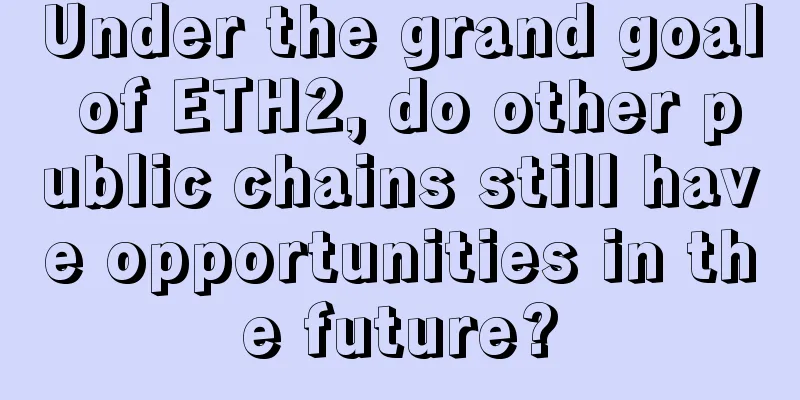Under the grand goal of ETH2, do other public chains still have opportunities in the future?

|
Many people who have experienced two rounds of bull markets should know that the main development direction of the market in this round of bull market is still DeFi, NFT and blockchain games, and there are fewer new public chain projects than in the last bull market. The successful development of Ethereum and the current performance limitations of 1.0 have given many other public chains opportunities, which also enables chains such as NEAR, Solana, BNB Chain, etc. to undertake the market demand after Ethereum DeFi. Even so, the beautiful vision depicted by Ethereum 2.0 will still become a very important part of the development of blockchain in the future. According to the previous description of 2.0, the first phase of sharding with 64 shards will greatly increase the transaction capacity of Ethereum, supporting 1,000 transactions per second. With the increase of shard chains in the future, TPS still has room for improvement. At that time, there will be no current transaction congestion problem. At the same time, because EVM is now supported by many other public chains, if Ethereum 2.0 is realized, the survival space of other public chains will be greatly reduced. In this way, whether other existing public chains still have opportunities may become the focus of many investors. As for other competing public chains at present, we all know that most blockchain project ecosystems are still concentrated on Ethereum. Although other public chains also have ecological project development, in terms of on-chain activity, except for Solana, Polygon and other chains that have certain strengths, most public chains are far behind. Although Ethereum's TPS is subject to certain restrictions, this has not prevented developers from deploying projects on Ethereum. On the contrary, in order to screen high-end user groups, some project parties still choose Ethereum as the preferred public chain for project deployment, rather than the cheaper Polygon or other public chains. For this situation, we need to recognize the background environment in which other competing chains still exist. First of all, we all know that the ecological development of most other competing chains is relatively slow compared to Ethereum, and the financial strength is not as sufficient as that of the Ethereum Foundation, but they play an important role in technical trial and error. For example, the important sharding function of Ethereum 2.0 we mentioned was actually first implemented on Zilliqa, and then it was planned to be adopted by Vitalik on Ethereum 2.0, which also avoids the problem of taking detours and wasting time in the process of technological development. In addition, the development of blockchain is not a one-way road. In the process of development, different public chains and technical solutions are actually an exploration process. With the intervention of capital, various technologies will have certain application scenarios and exploration processes in their respective fields. The kind of one-size-fits-all public chain technical solutions that people expect may be difficult to achieve. Public chains with different architectures will develop in different directions. For example, the storage we see is mainly Filecoin and AR, and sports and entertainment public chains like Flow are a good development ecosystem. Ethereum is currently a large and comprehensive public chain that pays more attention to balanced development. It may not be good at some professional functions. The third is the development of cross-chain, which is to gradually reduce the barriers between public chains and form a trend of free circulation of assets in the whole network. Another very important survival scenario of public chains is the existence of cross-chain. The current cross-chain is beneficial to other public chains, but not to Ethereum. This is mainly because the high cost of Ethereum transfers forces people to use low-cost public chains, which also promotes the rapid development of other public chains. Cross-chain allows assets to circulate on different public chains, which is actually equivalent to connecting various local area networks to an Internet to a certain extent. At this time, people will naturally not focus on which chain the application is on, but on whether a specific application solves everyone's pain points or problems. People will pay more attention to specific ecological applications, and the attention to the underlying public chain will gradually decrease. Fourth, capital supports other public chains. Capital supports different public chains to avoid the situation where Ethereum is the only one in the market. This phenomenon is like the competition between different enterprises in a certain industry. The big boss eats meat, the second one drinks soup, and the rest have their own living space, rather than the whole industry being occupied by the big boss and others lacking opportunities. When such a situation of one company dominating the market appears, it is also a form of centralization. Once a problem occurs, the entire network will be destroyed. Therefore, capital will not blindly support Ethereum in this case, and they will inevitably seek other competing products. Furthermore, we also need to consider the impact of geopolitics and protectionism in different countries around the world as the blockchain industry develops and grows. In order not to be controlled by others or to take over the existing mature public chains, some countries that are late to the development of blockchain will have a certain motivation to support their domestic groups to develop their own blockchain projects and ecosystems. In addition, most of the current blockchain project codes are open source, so if you want to make a replica, it is not difficult. In this way, various public chain projects will continue to appear in the future. Summarize In general, although the development of Ethereum is an important indicator of blockchain technology and applications, even if Ethereum 2.0 is successfully implemented, it will still be difficult to cause the phenomenon of "one chain succeeds and all chains fall" to a certain extent. Therefore, even in the next bull market, it is very likely that public chains with excellent architecture will still emerge to gain market recognition and popularity. |
Recommend
Is it good for a woman to have a mole at the left corner of her eye? What does a mole on a woman’s left eye mean?
Moles can be seen everywhere on people's face...
Is it good to have a blue forehead?
In physiognomy, a lot can be seen from the color ...
What is the fate of a woman with a mole on the right waist? What does a mole on the right waist of a woman mean?
The presence of many moles will affect everyone&#...
How to build your own mining pool - mining pool construction tutorial
The author translated this article for the sake o...
Viewpoint: Hong Kong should issue a Hong Kong dollar stablecoin backed by foreign exchange reserves
As the global digital asset market grows rapidly,...
A sagging marriage line means divorce.
If we compare our palms with those of people arou...
Is Jackie Chan's face good?
Is Jackie Chan's face good? Birthday is the m...
What is a good face diagram
As we all know, facial features are related to ou...
Nine out of ten bald men are rich. Are bald people more likely to get rich?
I believe everyone has heard the saying that nine...
Deloitte partners with blockchain startup Colu
Blockchain startup Colu has revealed that it has ...
This guy traveled around the world for a year with 1 Bitcoin, and even met Vitalik Buterin and John McAfee
Source: breakermag Compiled by: Carol Produced by...
What are the facial features of people who finish today's work today?
In fact, there is a very good habit called "...
Is it true that fools are always lucky?
A fool does not always have good luck, but a luck...
Bloomberg: Bitcoin missed a good opportunity to prove itself in economic turmoil
According to Bitpush data, for quite a long time,...
Is it a bear market now? Listen to the researcher's analysis of the current market situation
By Dylan LeClair, 21st Paradigm Lianchuang Compil...









